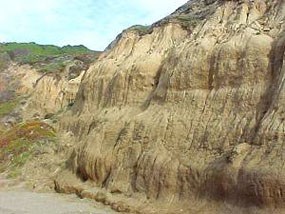
Will Elder, NPS The Colma Formation blankets the Franciscan Complex locally in the Presidio. The Colma is mostly comprised of sandy deposits laid down between 80,000 and 120,000 years ago, during the last major interglacial period. The origins of the poorly consolidated Colma sands are unclear, but they appear to represent shallow bay-to-dune, and valley-fill debris deposits. The formation extends under the San Francisco Bay and may be found as high as 500 feet above sea level. High sea levels, produced when much of the ice on the continents melted, allowed shallow marine rocks to be deposited on parts of the San Francisco Peninsula at that time. Apparently the rocks are mostly of shallow bay origin below the 200 foot elevation contour and are valley slope-debris at higher elevations. The environmental implications of these rocks deserve further study. |
Last updated: February 28, 2015
